A Hard Turn is Good to Find.
last updated 10feb19 & 20nov16 & 20dec15
When you’re ready to march to the beat of a different drummer, whether you need a new challenge or your rebel spirit compels you that way, this guide is offered to help you decide what binding to get.
When it comes to picking a telemark binding there are many things to consider. Releasability, downhill power, touring freedom, and weight are the dominant characteristics to consider. There is no right or wrong answer with any. The best binding for you is not necessarily the best for someone else based on the boot used, style of skiing, and goals.
Releaseability
Until Rottefella introducted NTN, the majority of telemark bindings did not have a safety release function. Today release is absolutely possible, provided you are using NTN boots, not 75mm. Even with NTN though, nothing is certified but examples testify it works.
To those who are coming from alpine skiing where the release value of bindings is adjustable, certified, and tested, this absence seems foolish. Yet, thousands of telemark skiers have learned and accepted that while this lack of release can result in injury, the inherent flexibility of the telemark boot/binding system tends to absorb forces that would cause injury in an alpine set up, and thus avoid those injuries; usually (see M. Tuggy, MD’s report). Please note, this ability to absorb forces is strongly dependent on your ability as a telemark skier to learn how to instinctively fall safely (generally a forward somersaulting action) to actively avoid injury. This may not be possible in all circumstances.
With NTN capturing half the new product sales, the availability of release has changed the options worth considering. If you are new to the sport and reluctant to trust in this system there are a few bindings that offer a safety release. The 7tm is the only telemark binding with a TUV certified safety release system. If you’re running in duckbills and insist on release, this is your trap. Voile made a releaseable binding for two decades. It worked with leather boots, but plastic telemark boots pre-released. The flaw was corrected around 2003, but it was too late; the CRB ceased production in 2006. Voile’s CRB is available in the used market only.
With the new crop of 2-pin tele bindings, especially the 2-pin Tele Norm (Meidjo, Lynx), there is a new component to release. In theory the Dynafit 2-pin concept appears to be incapable of holding a toe for skiing, yet those skiing on the bleeding edge of tele technology know that those pins hold just fine. In fact, they’re rather reluctant to let go, but they can, and hence, offer a baseline level of release. It adheres to the concept of tele release: possible but not reliable. Not consistently repeatable – yet possible.
Rottefella’s Freeride and Freedom tout release as does Olympus Mountain Gear’s TTS. 22 Designs doesn’t claim release in writing, but there are plenty of examples on the internet to show that Outlaw and Lynx can and do. The M Equipment’s Meidjo offers adjustable spring tension at the claw for the second heel with NTN boots. Not DIN certified, but it works and with a little trial and error adjustment, you’ll find a setting you trust.
Downhill Power
This is a factor that becomes very personal. Some people like a more active binding, some less. Activity describes how much the cable tension, or resistance to heel lift from the binding adds to the sensation of control when telemarking. Telemark bindings without cables, like a classic 3-pin binding, or Spike Lite, are considered neutral. Those with more spring tension in the cable are more active.
How much power you like will depend in part on how stiff the flex of your boot is, and how wide your skis are. Generally the wider your skis, and the stiffer your boots, the more active you will want your binding. A cable with more tension will help with flexing a stiffer boot, and deliver more power to the edges of wider skis. In softer snow conditions, and with a softer boot, or narrower skis, less tension is needed, or may be sacrificed in exchange for more powder sensitivity.
There is another, subtle factor at play with telemark bindings; how quickly the activity is engaged. Cable bindings that are routed underfoot tend to add tension faster than cable bindings that are routed along the side of the binding. In addition, the position of the pivot affects how quickly tension is engaged as the heel is lifted on the trailing foot. The further behind the toe it is, the faster it engages.
Downhill Ratings
|
Make/Model
|
Cable Routing
|
Pivot Pos’n
(behind pin line) |
Ramp Angle
|
Activity
(HH rating) |
Lateral
Control |
| 75mm Bindings | |||||
| 22D Axl |
Under
|
3, 4, 5cm
|
3°
|
3-5
|
4.5
|
| 7tm Pwr Tour |
Under
|
2cm
|
0
|
2-3
|
3
|
| Bishop BMF-R |
Under
|
65mm
|
2°
|
3-5½
|
5
|
| Blk Diamond O1 |
Under
|
2 cm
|
0
|
2-4
|
4
|
| BMD Spike XT |
Under
|
3-5cm
|
0
|
3-5
|
4
|
| Brnt Mt. Spike Lite |
n/a
|
n/a
|
n/a
|
1.5
|
2
|
| G3 Targa Ascent |
Side
|
2
|
3°
|
2-3
|
2.5
|
| G3 Enzo |
Under
|
2.5-5cm
|
3°
|
2-4.5
|
3
|
| Voile Switchback |
Side
|
2 cm
|
3°
|
2-3
|
3
|
| V Switchback X2 |
Side
|
3 cm
|
3°
|
3.5
|
3.5
|
| Voile 3-pin |
n/a
|
n/a
|
0
|
1
|
2
|
| NTN Bindings | |||||
| 22D Outlaw |
Under
|
56 mm
|
1°
|
3-5
|
5
|
| Bishop BMF-R |
Under
|
65mm
|
2°
|
3-5½
|
5
|
| BMD Spike NT |
Under
|
3-5cm
|
0
|
3-5
|
4
|
Rottefella FreeRide |
Under
|
n/a
|
0
|
3-5
|
5
|
| Rottefella Freedom |
Under
|
n/a
|
curved
|
2-4
|
3.5
|
| 2P Tele Bindings | |||||
| 22D Lynx |
Under/Leaf
|
50 mm
|
n/a
|
3-4
|
5
|
| M-Equip Meidjo |
Under
|
56mm
|
n/a
|
2-3
|
5
|
| OMG TTS |
Under
|
50–82mm
|
n/a
|
4-5
|
4.5
|
The ratings in the table above are based on the Hammerhead scale, a cable binding developed by Rainey Designs with underfoot cable routing and adjustable cable pivot points. The numbers correspond to the cable pivot positions, from 1 to 5 with 5 being the furthest aft from the toe of the boot, and the most active. The most popular position, or power activity, is probably a tie between HH#3 and HH#4.
If you are learning to telemark a binding with an adjustable pivot location is recommended. You will be more comfortable adapting to a free heel with a lot of tension to begin with. However, it is recommended that as you gain balance and confidence that you dial down the tension to help learn the nuances of the telemark turn. Experienced leathernecks will assure you the telemark turn can only be fully mastered through the trials of learning to adapt with a soft boot and a neutral binding. That may not be completely true, but the perseverance it requires always yields improvements to technique.
Touring Freedom
There are many reasons to want to telemark, but since this site is focused on earning turns, bindings that don’t tour well are not presented. I tend to classify the touring function of telemark bindings as Awesome (those with a free-pivot feature), Bearable (low resistance to heel lift), and Sufferable (cable bindings with high resistance to heel lift). The downhill performance of cable bindings without a tour mode are identical to their siblings that have the tour mode, with a modest reduction in weight and a dramatic decrease in touring efficiency. When you are earning your turns in the skin track, resistance is futile.
The less friction or resistance there is to lifting your heel, and the lighter the weight, the better the touring capability. How far you can lift the heel, the range of motion, without resistance is a part of the resistance equation. More ROM yields less overall resistance and greater efficiency. In addition, the position of the pivot can affect efficiency. The further in front of your toe it is, the more inertial resistance there is. This is subtle, but is also affected by the weight of the binding and how far it extends behind the pivot. The more there is, the greater the inertial resistance affecting efficiency.
Since the new millenium, touring specific telemark bindings have a distinct tour mode. In most cases this is a switch that allows the toe plate to pivot freely, or with dramatically reduced resistance. How easy that switch is to engage is part of the touring value of a binding.
There are currently three touring configurations to chose from, in order of development:
- 75mm free-pivot cable bindings (75mm duckbilled boot)
7tm Pwr Tour
G3 Ascent (discontinued)
Black Diamond O1 (discontinued)
Voile Switchback
Burnt Mountain Designs Spike XT
22 Designs Axl
Voile Switchback X2
G3 Enzo (discontinued) - NTN bindings (NTN boot)
Rottefella Freeride (w/medium resistance pivot, 30° ROM)
Rottefella Freedom (w/low resistance pivot, 45° ROM)
22 Designs Outlaw (free-pivot, 55°+ ROM)
Burnt Mountain Designs Spike NT (free-pivot, NTN compatible but not true NTN) - Telemark Tech bindings (NTN boot with tech fittings)
OMG Telemark Tech System
Moonlight Mountain Gear Tele Pure
The M Equipment Meidjo v2 (TTS/NTN hybrid)
Weight
Weight is the easiest feature to check, and generally speaking, the least important to consider. For in-bounds skiing it is irrelevant. For earning turns, all other features being equal, lighter is better.
Icing
The tendency for a binding to ice up is largely due to snow conditions. Moist, sticky snow is more likely to glam onto your bindings and pack into ice which increases the weight you are carrying, and can frustrate the ability to easily switch from touring back to turning mode. However, some bindings are more prone to icing than others.
In some cases you only need to toggle the mode switch back and forth a few times to dislodge the ice. In other cases you need to step out of the binding and chip the ice off; a deft jab with a ski pole can do the trick, sometimes you need a screwdriver. In descending order of likelihood that ice will hamper mode switching: G3’s Ascent, Rottefella’s Freedom, R’s Freeride, Meidjo, BD’s O1, 22D’s Axl, Switchback X2, 22D’s Outlaw, 7tm Power Tour, Switchback, and G3’s Enzo. Snow can pack underfoot with TTS, preventing your foot from resting flat. It doesn’t prevent adding or removing the heel, but you’ll want to clean out the buildup before heading down.
Touring Ratings
|
Make/Model
|
Class
|
Weight
(oz) |
Weight
(grams) |
Pivot
(mm) |
ROM
|
Icing
|
Peg Ease
|
Rating
|
| 75mm Bindings | ||||||||
| 7tm Pwr Tour |
A-
|
33
|
940
|
+14
|
65+°
|
½
|
1
|
3.75
|
| 22D Axl |
A
|
32
|
910
|
0
|
45+°
|
2½
|
5
|
4.25
|
| Bishop BMF-R |
A
|
33½
|
950
|
-2
|
50+°
|
2½
|
3
|
2
|
| Blk Diamond O1 |
A
|
30
|
850
|
-2
|
60+°
|
2
|
2.5
|
4.5
|
| BMD Spike XT |
A
|
28
|
750
|
+8
|
45+°
|
n/a
|
3
|
3.75
|
| BMD Spike Lite |
B
|
13
|
370
|
n/a
|
½
|
3
|
3
|
|
| G3 Ascent |
A
|
25
|
710
|
+5
|
55+°
|
4
|
5
|
4
|
| G3 Enzo |
A
|
31
|
880
|
0
|
50+°
|
0
|
4
|
4.5
|
| Voile Switchback |
A
|
24
|
680
|
+4
|
50+°
|
½
|
3
|
5
|
| V Switchback X2 |
A
|
26
|
740
|
+4
|
50+°
|
¾
|
3
|
4.75
|
| Voile 3-pin |
B
|
7¾
|
440
|
0
|
2.5
|
NTN Bindings | ||
| 22D Outlaw |
A
|
29½
|
835
|
0
|
55+°
|
1½
|
5
|
4.5
|
| BMD Spike NT |
A
|
28
|
750
|
+8
|
45+°
|
?
|
3
|
3.75
|
| Rotte Freeride |
B+
|
32.6
|
925
|
+5
|
30°
|
1
|
3
|
2.5
|
| Rotte Freedom |
A-
|
27
|
775
|
-5
|
50+°
|
3
|
4
|
3.75
|
2P Tele Bindings |
| 22D Lynx |
A
|
18½
|
525
|
0
|
90°
|
1
|
5
|
4.75
|
| M-Equip Meidjo |
A
|
20
|
575
|
0
|
90°
|
2
|
4
|
4.75
|
| OMG TTS |
A
|
17½
|
495
|
0
|
90°
|
1½
|
2
|
4.75
|
In the touring ratings above the final rating is predominantly determined by how frictionless the pivot is. Ideally all telemark bindings with a free-pivot for touring get a rating of 5, but then other factors can erode that efficiency such as the touring ROM, weight, how easy the climbing posts are to engage, and a binding’s propensity for icing up. A higher value for icing means it is more likely to ice up, hampering mode switching. The values are relative.
Final Selection
With two different systems you need to decide which way to go: Classic 75mm with a duckbill, or NTN with a duckbutt. There are more choices in the 75mm category, and they are all solid choices, but what is possible in terms of power and freedom have pretty much limited out. That’s a pretty high limit compared to back in the day, but a limit nonetheless.
The limit of what is possible with NTN is unknown. With NTN there are fewer boot and nearly equal binding choices. They offer an improved range of power and freedom, but you need to be more careful in the boot you choose. If you want a frictionless pivot for touring, be sure to get a boot with tech fittings so you can either switch between a telemark binding using a 2-pin tech toe (TTS) or an AT binding. That’s another possible benefit of NTN, with a pre-2016 boot you could switch hit with the same boot and lock your heel if you desire, although most prefer a more rigid AT boot when locking the heel (After 2016 NTN boots with tech fittings will not come with the heel insert. This limits the alpine functionality to plate bindings, a desperate decision at best.).
With NTN there are more choices for a releasable binding. Generally speaking these systems provide more lateral control, and plenty of power. The boots are also lighter compared to their 75mm equivalents.
While there are lots of choices to be made, hopefully the tables above and guidelines presented here will clarify, not confuse you when you’re ready to buy.
Remember, not everyone can tele.
A hard turn is good to find.
Related Posts:
Risk of knee injury with telemark equipment, by M. Tuggy MDn (broken link – No longer available ;-( )
Revised report on Telemark Knee Injuries, by M. Tuggy MD
G3 Enzo discontinued
2012 Telemark Binding Selection Chart
February 2019 Update Synopsis: Added Lynx, Bishop-BMF-R to tables. Updated text related to release to reflect NTN options available.
© 2014

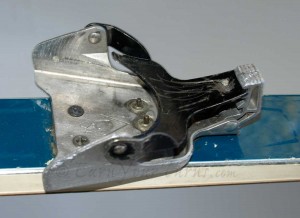
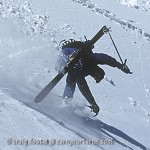
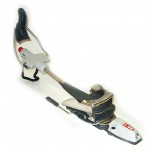

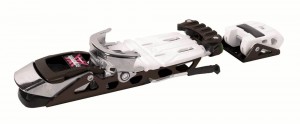
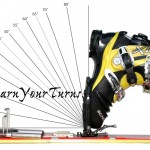
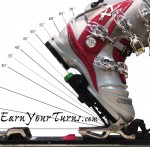
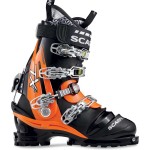
15 comments
2 pings
Skip to comment form
A great round-up. Thanks.
Telebry make release plates for common 75mm bindings: DIN rated & release in all directions unlike the 7TM. They also have a release brake option. A lockable step-in heel assembly is also part of the suite.
There is an imprecision since the weight for the Voilé 3-pin (I guess it refers to the
plain 3-pin HD Mountaineer) is given for a pair while all other ones are given
for the single binding. For a confrontation it should be halved to 220 g which
is much lower the any other binding. Besides there are other Voilé options such
as the 3-pin cable at 405 g and the 3-pin Hardwire at 650 g. Both couple the relative ROM of a 3-pin while skinning with a good amount of spring tension downhill. It should be added that all these binding are much cheaper than all other choices.
An “extreme” choice is the very light ATK Newmark with a 2-pin system and a 3-pin level of activity at 142,5 g!
A final addition for sale the coming season is the M-Equipment Meidjo which combines TTS with a second heel retention as for NTN, safety release, step-in and optional brakes.
Good catch there Frank. Weight of Voile’s 3-pin is now per binding, not per pair. The 3-pin HW should perhaps be there, but I don’t know why anyone would buy that over the Switchback. ATK isn’t included ‘cuz I’ve never skied it. AFAIK, it is NOT available in the US. There are other 2-pin tech tele bindings coming, but they won’t be added until they’ve been evaluated. Otherwise, I’d just be guessing on some of the relative values.
Also add Supertelemark (Rottefella) at 370g/pair or 185g/piece?
Great summary, Dostie, you wrote
“That’s another benefit of NTN, …..you can lock your heel if you desire.” (with a NTN boot with tech inserts at the toe and heel,)
Well in order to prevent boot sole flex, and unwelcome pre-release an NTN boot in a tech binding, requires a nylon plug, aka the “hockey puck” to fit under the boot. This plug , included with my TX boots fits into the crampon slot on a Dynafit tech binding. If your pin-toe piece doesn’t have the dynafit spec crampon slot it won’t work.
So using an NTN boot in a tech binding could be a bit fiddly IMHO.
And whet about the rottefella r8 cobra?
You probably didn’t notice, but this guide does not consider any bindings without at least a bearable touring feature. The Cobra R8s are like all first gen cable bindings when it comes to skinning efficiency – they are sufferable – but when you can get awesome (via a free pivot), why suffer when you need not?
As far as ski ability, downhill wise, I’d consider them to be pretty equivalent to something like the BD O1, or the Voile Switchback X2. More than less.
I use the 22 Axl for Off-Piste and Touring, great downhill performance, solid for jumps and aggressive skiing.
But: the free pivot has just +/-85° (better would 100°) so it doesn t work well in steep terrain where kick-turns are necessary. The crampons offered for the Axl are a desaster. Attached with a thin clip, they wiggle and you loose them after a few meteres in the flat. Not usable. 22 offered me Money back and agreed, “we’re also not happy with the crampons’ performance”
The Axl is very limited in its touring perfomrance. Nothing for icy conditions, glaciers or longer transits
Whack some Voile crampons on the skis for icy stuff but if it’s serious terrain you’d be wearing boot crampons anyway.
I don’t know what you mean by nothing for glaciers or longer transits.
I find them fine for touring except they’re on the heavy side. With Telebry Safeouts I have a releasable rig with brakes.
Tnx, Great summary, been looking for such awhile now. Intrigued by the Pivot Position (Downhill ratings table) extreme of TTS (5-8.2cm compared to the other binding ~2-3cm. Is there a fundamental reason why a tech-toe binding needs requires huge activity, i.e. large Pivot Position distance?
What bindings are least likely to get pulled out of a ski? Do Quiver Killer kits help decrease this problem?
Anything that’s properly screwed and glued will work.
OTOH having bindings or plates ripped out may save your bones. On the other other hand having this happen when remote would be a pain of a different sort.
I notice that 22 Designs have just rereleased crampons for the Axls, bless their paws and whiskers.
QK or BF inserts will theoretically improve retention. IME it does make a difference and I’ve never pulled a binding out that had inserts on the back holes for the toe plate. It still depends on the quality of the work done – garbage in (crappy mounting), garbage out (bindings pull out of skis). It is not so much binding dependent as quality of work. That said, more active bindings are more likely to get ripped out – perhaps not because of the binding but because the binding is used by more aggressive skiers who are more likely to stress a mediocre mount job. YMMV.
Absotively – without the cable there’s nothing preventing your heel coming up. A 75mm binding has the duckbill to help provide something to flex against, a 2-pin toe does not. And you can adjust the position of the cable with a TTS binding so that it is not so active. Those are the positions recommended by OMG for their Telemark Tech System. You are free to place the cable block elsewhere.
[…] This is a dry run of a page that I’m working on for helping people select a telemark binding. Your feedback, input, and criticism are requested. This isn’t complete yet because some of the relevant bindings are still absent in the archives of reviews available. Some will be published soon, others a bit later. But the basic guidelines will, provided it passes muster with your criticism, remain essentially the same with the addition of new options. (Updated 2014 Selection Guide) […]
[…] We talked about a lot of binding models, See Craig’s binding review […]